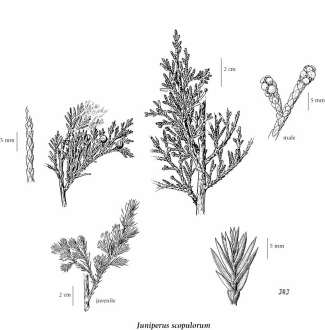Rocky Mountain juniper
Cupressaceae (Cypress family)
Introduction to Vascular Plants
Species Information click to expand contents
General:
Usually a small, erect evergreen tree to 10 m tall, with conical form, but also a sprawling shrub less than 1 m; bark reddish-brown, scaly or fibrous and stringy.
Leaves:
Mostly scalelike, opposite, not prickly, but young leaves needle-like, 5-7 mm long, in whorls of three on stem.
Cones:
Seed cones fleshy, berrylike, 5-6 mm long, bluish-purple when mature, glaucous; pollen and seed cones on separate plants.
Notes:
See J. horizontalis for discussion of hybridization.
Illustration click to expand contents

If more than one illustration is available for a species (e.g., separate illustrations were provided for two subspecies) then links to the separate images will be provided below. Note that individual subspecies or varietal illustrations are not always available.
Illustration Source: The Illustrated Flora of British Columbia
USDA Species Characteristics click to expand contents
Flower Colour:
Yellow
Blooming Period:
Early Spring
Fruit/Seed characteristics:
Colour: Blue
Present from Fall to Winter
Source: The USDA
Ecology click to expand contents
The table below shows the species-specific information calculated from
original data (BEC database) provided by the BC Ministry of Forests and Range.
(Updated August, 2013)
| Site Information |
Value / Class |
||
|
Avg |
Min |
Max |
|
| Elevation
(metres) |
980 | 15 | 2854 |
| Slope
Gradient (%) |
36 | 0 | 160 |
|
Aspect (degrees) |
193 | 0 | 360 |
| Soil
Moisture Regime (SMR) [0 - very xeric; 4 - mesic; 8 - hydric] |
2 | 0 | 7 |
| Modal
Nutrient Regime
Class |
C | ||
| #
of field plots species was recorded in: |
1260 | ||
| Modal
BEC Zone Class |
IDF | ||
|
All BEC Zones (# of stations/zone) species was recorded in |
AT(2), BG(126), BWBS(6), CDF(1), CWH(3), ESSF(23), ICH(74), IDF(729), MS(138), PP(82), SBPS(5), SBS(36), SWB(1) | ||
|
Source:
Klinkenberg 2013
|
|||
Habitat and Range click to expand contents
Status Information click to expand contents
Synonyms click to expand contents
Synonyms and Alternate Names:
Juniperus scopulorum var. columnaris Fassett
Juniperus virginiana subsp. scopulorum (Sarg.) E. Murray
Juniperus virginiana var. montana Vasey
Juniperus virginiana var. scopulorum (Sarg.) Lemmon
Sabina scopulorum (Sarg.) Rydb.
Taxonomic Keys click to expand contents
TAXONOMIC KEY TO JUNIPERUS
1. Leaves awl-shaped, in whorls of 3, spreading; the berrylike fruits sessile in the leaf axils J. communis 1. Leaves mostly scalelike, opposite, appressed to stem; the berrylike-like fruits terminal on the branchlets. 2. Low, spreading or creeping shrubs; fruits recurved on short stalks J. horizontalis 2. Small trees or erect shrubs; fruits erect or nodding J. scopulorum Source The Illustrated Flora of British Columbia Note that since the publication of the Illustrated Flora, new species have been added to the BC flora, and are not incorporated in the keys. |